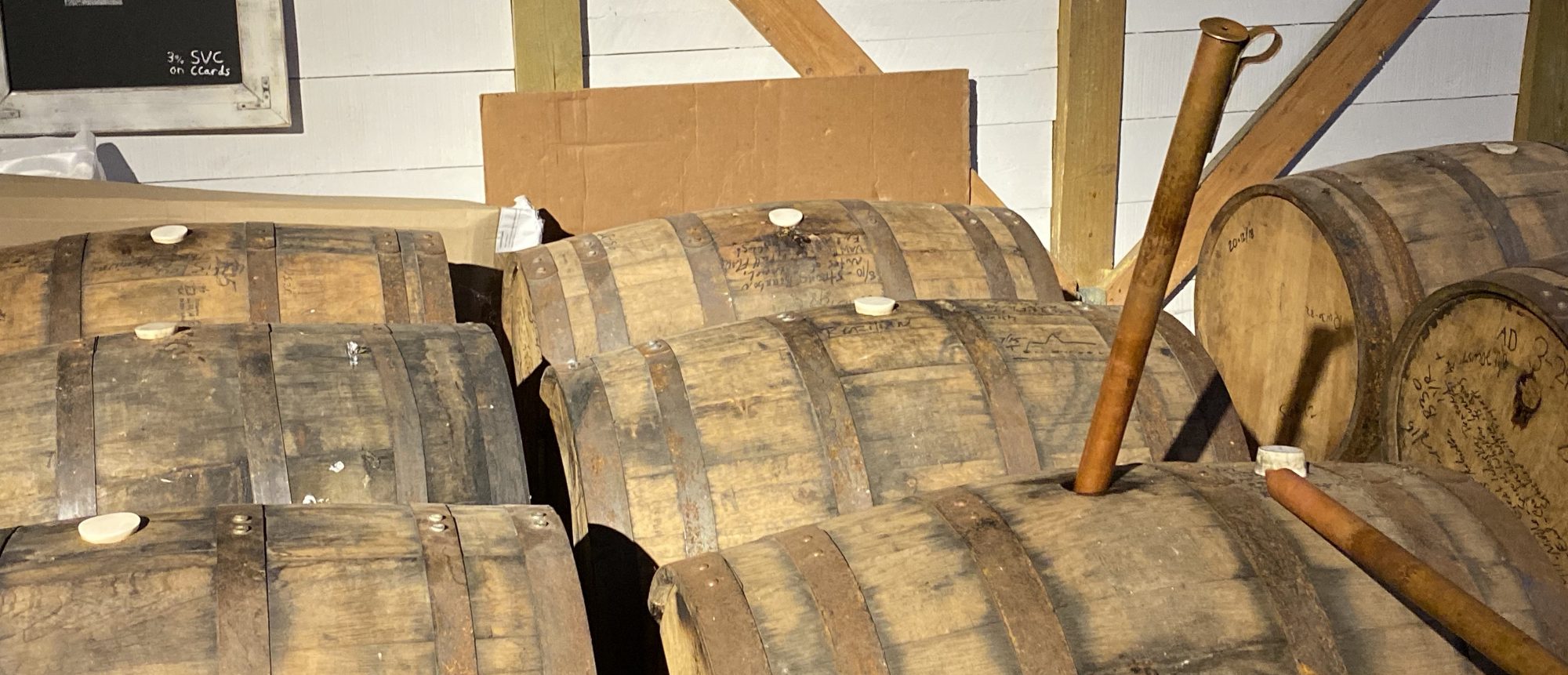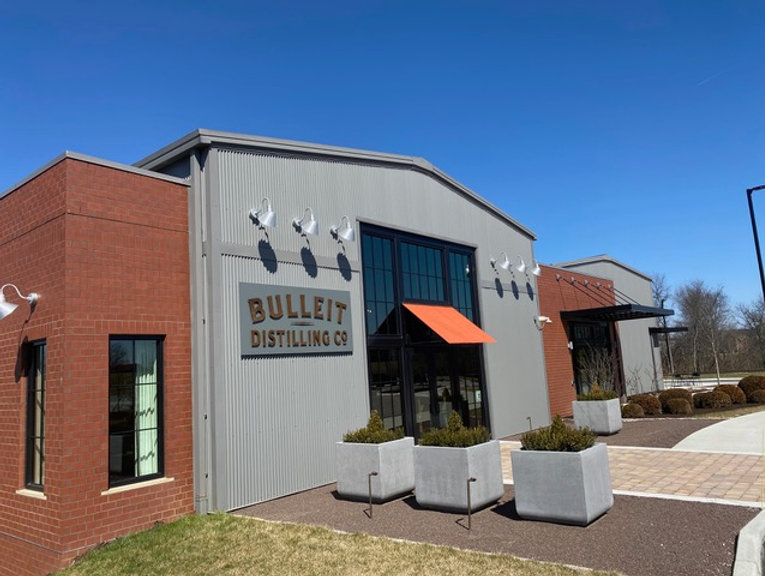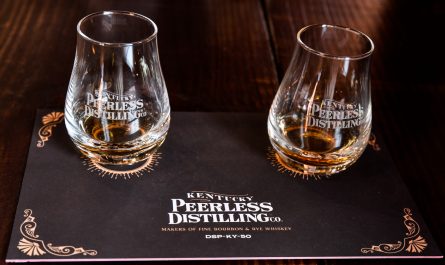For a company that calls its products Frontier Whiskey, Bulleit Distilling Co. sure has some new-fangled ideas and modern ways of doing things.
The company has a unique commitment to three main areas: environmental sustainability in its production, supporting folks in the hospitality industry in these tough times, and partnering with artists in local communities. All the while, continuing to serve an exploding market for its high-rye bourbon and rye whiskies that come in distinctive embossed glass bottles.
In mid-February, on a weekend bookended by an ice storm and a coming snowstorm, I toured the Bulleit Distilling Co.Visitor Experience in Kentucky. The state-of-the-art distillery opened in 2016 on 300 acres in the Shelby County countryside, about 40 minutes outside Louisville.
Melissa Rift, Bulleit’s Single Barrel Ambassador, served as our tour guide for a group of nine visitors from Illinois, Florida, Iowa, and Kentucky.
Rift told us how Tom Bulleit left his law practice in 1987 to start a bourbon brand: “It really is this idea that Tom had, having taken the inspiration from the old family recipe. His great-great-grandfather, Augustus Bulleit, originated this recipe on the Kentucky frontier. Tom loved the spirit of pioneers…and turned it into the spirit of our brand.”
In the late 1980s, bourbon wasn’t the massive consumer favorite it is now. Bulleit worked with bar and restaurant owners, especially on the West Coast, to showcase this new high-rye bourbon.
“We become known kind of as the ‘bartenders’ bourbon’ in our early years: High-rye recipes, spicy, bold recipes that stand up really well in an Old Fashioned and other cocktails,” Rift said. “And you start seeing Bulleit Bourbon showing up on cocktail menus all over the country. We skyrocket and become one of the fastest-growing bourbon brands in the United States.”
Bulleit is now owned by spirits giant Diageo, which counts Guinness, Johnnie Walker, Smirnoff, and Tanqueray among its more than 200 worldwide brands.
Diageo also owns the Stitzel-Willer Distillery in Shively, a suburb of Louisville, which is now the home of Blade and Bow Bourbon. Bulleit called Stitzel-Weller home until moving into its new facility in Shelbyville.
The Shively distillery is currently adding to its visitors’ center. Watch for that story in an upcoming Bourbon Spirit Column.


Sustainable Distillation is a Major Commitment
As we rode one of their two propane buses from the visitors’ center over to the distillery, Rift elaborated on the first of the company’s key commitments: “Bulleit has really become a loud voice in the conversation about sustainable distillation.”
“Just to highlight a couple things about sustainable distillation: it basically means you want to be using your natural resources to the best of your ability, with as little waste, and as much attention paid as possible to conservation.” Rift noted that switching the buses to propane meant 13 percent fewer greenhouse gases in the air.
All of the corn in Bulleit Bourbon (which is 68 percent of its mash bill) is grown within a 30-mile range of the distillery in Shelby County. “It’s really good because it gives back to the community-focused agriculture here,” Rift said. “It’s also good because the trucks that deliver it only have to drive a couple of miles down the road to get to us. That’s a lot fewer emissions going into the air everyday.”
In addition to reducing the carbon footprint, the distillery is a zero-waste-to-landfill production-site: “Something we’re really proud of and not something you find at every bourbon distillery,” Rift said. “We reuse and recycle 100 percent of waste throughout the process.”
We passed a weathered old wooden barn adorned with icicles on one side of the bus. Rift drew our attention to the other side, where a large retention pond sits. The Bulleit distilling process draws water from Guist Creek, the source of all the water in the county. This focus on water stewardship means capturing, treating, and reusing water that might otherwise be wasted.
As we pulled up to the main distillery building, Rift pointed out the solar panels; they power all the outdoor lighting and the fork lifts on site. The first large industrial solar power array in Shelby County means “renewable power we’re able to route back to the county power grid.”
Bulleit is set to open a second distillery this year in Lebanon Kentucky, doubling its capacity, to produce 10 million proof gallons per year using 100 percent renewable electricity and net-zero carbon emissions. This new bourbon and American whiskey production plant will not be open to the public.
Bobby Burk, who directs the Bulleit Frontier Ambassador program, coordinates cultural outreach for the company. He reinforced everything I learned on the tour about the company’s commitment to the environment, citing Diageo’s 10-year sustainability plan.
“Diageo has something called ‘grain to glass.’ Our commitment is a fully 360-degree sustainability proposition. From liquid to lips,” Burk said. “We are very proud to keep plastics to a minimum, to keep pushing the solar profile, along with many other efforts. Sustainability is where our bread is buttered on the commercial side and the socially conscious side of our business. Consumers, bar tenders, and bar owners want that, as well.”
Burk said that Bulleit announced a partnership last year with conservation non-profit American Forests to plant one million white oak trees in the Eastern US over the next five years.
Tour Highlights Include Computer Control Room and Copper Still


Three quick highlights stood out to me on the production facility tour. First was the high-tech computer room which is staffed round-the-clock to control the distilling process.
“The computer system helps us with efficiency, quality, and consistency,” Rift said. “But these computers do not replace our wonderful distillers; they are outside this room touching every part of the process, every single day. The computers help elevate quality and consistency of our liquids — meaning that every time you open a bottle of Bulleit, it’s going to be really good and it’s going to taste exactly the same.”
A second highlight of the tour: it intrigued me to learn that Bulleit has a palletized system to store its aging barrels vertically (with the bung on the barrel head) in its one-story steel warehouse. Most distilleries rest their barrels horizontally as they age.
Final highlight (again, my opinion…that’s why you should take the tour yourself): Bulleit has a cutaway-view replica of the copper column still made by Vendome Copper & Brass Works in Louisville. It offers one of the clearest views (with a helpful explanation from our tour guide) of the modern distilling process.
The multi-sensory tasting at the end of the tour is quite a treat as well. Lights and music coordinate with each of the four offerings (Bulleit Bourbon, Bulleit Bourbon 10-Year, Bulleit Rye, and Bulleit Bourbon Barrel Strength). Each tasting comes with its own scent bulb with a variety of curated fruit and spice aromas that help you fine-tune the aromas you’re nosing in each whiskey. Again, thanks to Melissa Rift, who really knows her Bulleit whiskies.
After the tour and tasting ended, I spoke to Jeff and Celia, who were part of the tour group. The couple is from Chicago and came to the Louisville area for the long weekend. While they are familiar with the many breweries around Chicago, making bourbon was a new experience for them.
“I loved it,” Jeff said. “Being talked through the complexities of the aromas, of what you can taste and decipher, that helps me enjoy it.”
Celia added, “As someone who does not drink bourbon or whiskey, I learned a lot today. I feel like I went in knowing nothing. I loved the cocktail recommendations, since I’m more of a cocktail drinker.”
Bulleit Frontier Fund Helps Hospitality Industry Folks in Need

Since Bulleit feels it owes much of its success to hospitality professionals, the second strong commitment the company has — giving back to that community.
“The Bulleit Frontier Fund is something we’ve been working on since COVID hit the restaurant and bar industry so hard,” Burk said. It’s a fundraising effort to assist hospitality professionals, but also includes a variety of programs that puts out-of-work bartenders to work creating craft cocktails and delivering them straight to your home, and hiring bartenders to stage workshops online on cocktail creation and other subjects.
Earlier, Rift told the tour group, “We love to give back to bartenders for that reason. That’s still a huge part of our brand — collaborating with bartenders. We’ve done a lot with them in the last year during the pandemic economic downturn.”
Bulleit Frontier Works Partners with Local Creatives

The third unique commitment that Bulleit puts it energy behind is a partnership with local artists and other creative types. The website describes the Bulleit Frontier Works program this way: “a series of projects where Bulleit collaborates with people who are pushing the frontier of their craft or expertise. Whether that’s creating the world’s largest tattoo billboard or giving new life to the old craft of neon signs, all of our Frontier Works projects highlight the interesting people and places at the edge of the modern frontier.”
The tattoo billboard, created by artists from all over, is on display in the Bulleit Visitor Center. Other projects, including some beautiful work in neon, are in major cities around the nation.
Bulleit Whiskey is Really the Frontier Spirit of Its People
After the tour, Burk took me downstairs to the single barrel tasting room, which he helped put together. We sat around a custom-made oak slab table with Bulleit Bourbon mixed into the finish, looking at a wall full of taps that dispense bourbon from different barrels.
In his more-than-a-decade with Bulleit, Burk has seen the company grow from distilling around 20,000 cases of whiskey to almost 2 million cases.
While the high-rye bourbons are certainly popular, it’s the ryes that really dominate their marketplace. “We are two-thirds of the rye category, we are the world’s leading rye,” Burk said. “There is not a bigger rye than ours, not just by volume but approachability too. I don’t mean this in a pompous way…we’re very proud. We have a great little recipe.”
When asked about the future for Bulleit, Burk cited the tremendous growth in production, while maintaining the company’s commitment to the environment and philanthropy. It seems the modern technology, impressive as it may be, is overshadowed by the frontier spirit of its people.
“We’re most proud of how we treat people and what we do differently,” Burk said. “Everybody, at the end of the day, should be inclusive, and caring, and hospitable.”
I think Augustus Bulleit would approve.

Bulleit by the Numbers:
Shelbyville, Kentucky Distillery
– 300 acres of land
– 12 aging warehouses (with more to come)
– Distilling 250 barrels a day
– 2 mash bills, 5 proprietary yeast strains, 10 maturates
– Bourbon
-Mash bill: 68 percent corn, 28 percent rye, 4 percent malted barley
– 90 proof
– Suggest retail price $24.99
– Rye
– Mash bill: 95 percent rye, 5 percent malted barley
– 90 proof
– Suggested retail price $24.99
– Distilled offsite in Lawrenceburg, Indiana





